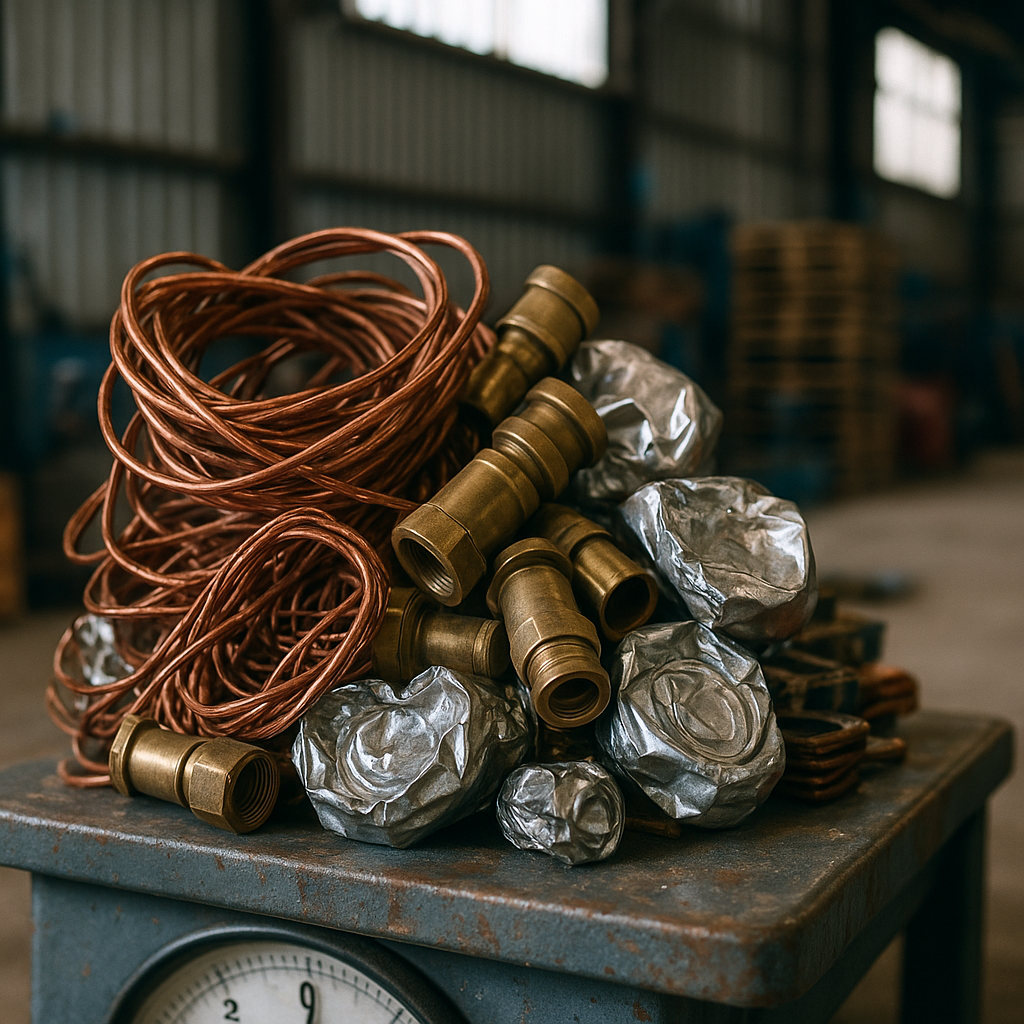5901 Botham Jean Blvd, Dallas, TX 75215
Discover the Highest Paying Scrap Metals in 2025?
September 6, 2025Looking to turn your scrap metal collection into cash? Not all metals offer the same returns. In 2025, copper is the most valuable, with current price indexes showing copper commanding $3.50-4.50 per pound at most scrapyards, making it worth 30-40 times more than standard steel. This demand explains why copper wire and piping are prime targets for both professional recyclers and occasional collectors.
Following copper, brass typically fetches around $2.20-3.30 per pound, about half of copper’s value. This golden-hued alloy, commonly found in plumbing fixtures and decorative items, offers substantial returns when recycled. Aluminum is next in line, with prices at $0.60-0.90 per pound for clean material, representing about 15-20% of copper’s worth. Steel remains crucial to the recycling economy but is valued lower, at approximately $120-175 per ton.
For regular scrap metal collectors, these price differentials can lead to significant income. Most casual collectors report earning between $50-200 monthly, depending on their access to higher-value metals like copper and brass compared to more common materials like steel and aluminum.
Why is Copper the King of Scrap Metals?

Copper reigns supreme in the scrap metal hierarchy, commanding prices that far exceed those of other common metals. Current market rates for copper scrap are typically 30-40 times higher than steel and about 5 times more than aluminum. This significant price difference makes copper the undisputed king of the scrap metal world.
The exceptional value of copper primarily stems from its outstanding electrical conductivity. Few materials can match copper’s efficiency in conducting electricity, making it essential for countless applications where energy transfer is critical. This property creates consistent, high demand across multiple industries.
Copper’s corrosion resistance further enhances its value in the recycling market. Unlike many metals that deteriorate quickly when exposed to moisture and air, copper forms a protective patina that shields the underlying metal. This natural barrier prevents further degradation and explains why copper components can remain functional for decades, even in challenging environments.
Industries That Depend on Copper
The electrical and electronics sectors consume vast quantities of copper for wiring, circuit boards, and components. Modern homes contain hundreds of feet of copper wiring, while industrial facilities often house miles of it. The renewable energy boom has increased demand, as wind turbines and solar panels require significant amounts of copper to function efficiently.
Construction and plumbing industries rely heavily on copper piping and fixtures. The healthcare sector values copper for its natural antimicrobial properties. Automotive manufacturing uses copper in everything from electrical systems to radiators. This widespread application across diverse sectors creates consistent demand that keeps copper prices high.
Common Sources of Valuable Copper Scrap
You might be surprised by how much valuable copper surrounds you daily. Electrical wiring represents one of the most common sources, found in walls, appliances, and electronic devices. Plumbing systems contain copper pipes and fittings that retain significant value even after decades of use.
Air conditioning units and heat exchangers contain copper coils and tubing that recyclers prize. Old electronics like computers, televisions, and mobile phones harbor copper in their circuit boards and components. Even everyday items like pots, pans, and decorative objects may contain recoverable copper.
Among all copper scrap types, bare bright copper wire commands the highest prices. This clean, uninsulated copper wire must be completely free of coatings, solder, or corrosion to qualify for top rates. The purity and ready recyclability of bare bright copper make it particularly valuable to processors who can immediately reintroduce it into manufacturing.
Copper’s Recycling Efficiency
Copper’s recycling efficiency adds to its value proposition. The metal can be recycled repeatedly without losing its essential properties. Recycling copper requires up to 85% less energy than mining and refining new copper, significantly reducing environmental impact while preserving a finite resource.
The combination of high demand, limited supply, and perfect recyclability creates a strong economic incentive for copper recovery. This explains why copper theft remains a persistent problem, with thieves targeting everything from construction sites to utility infrastructure.
For businesses and individuals alike, understanding copper’s value can transform waste management practices. Items that might otherwise end up in landfills represent potential revenue when properly sorted and recycled. Even small quantities of copper can yield meaningful returns compared to other scrap metals.
How Can You Maximize Your Scrap Metal Earnings?

The difference between modest returns and substantial profits in scrap metal recycling often comes down to preparation and strategy. With the right approach, you can significantly increase your earnings from materials that might otherwise be undervalued.
Metal identification is your first step toward maximizing profits. Using a simple magnet test can quickly separate ferrous (magnetic) from non-ferrous (non-magnetic) metals. Non-ferrous metals like copper, brass, and aluminum typically command higher prices. Learning to distinguish between metal types by appearance can prevent you from selling valuable metals at lower rates.
Sorting your metals properly is perhaps the most impactful strategy for increasing earnings. According to recycling industry data, properly sorted metals can fetch 20-40% more than mixed materials. For certain combinations, the difference can be even more dramatic. Sorting stainless steel from regular steel, for instance, can increase your earnings by up to 170%, as stainless is often missed in mixed loads.
Preparation Techniques That Boost Value
Cleaning your scrap is crucial for maximizing value. Remove non-metal attachments like plastic, rubber, or wood components before selling. For example, copper wire with the insulation removed can be worth up to 30% more than insulated wire. Similarly, removing contaminants like paint, dirt, and grease from aluminum can increase its value by 15-25%.
Quantity matters in the scrap metal business. Many recyclers offer better rates for larger quantities, so consider collecting and storing your scrap until you have accumulated enough to justify a trip to the recycling center. This approach not only saves on transportation costs but can also result in better per-pound pricing.
Organization is key to efficient sorting and maximum returns. Designate specific containers for different metal types to prevent cross-contamination. Label each container clearly and maintain separation throughout the collection process. This simple practice prevents the devaluation that occurs when higher-value metals mix with lower-value ones.
Strategic Timing for Better Prices
Market timing can significantly impact your earnings. Metal prices fluctuate based on global market conditions, with spring and summer generally offering higher prices due to increased construction activity. Monitoring price trends through websites or apps dedicated to scrap metal pricing can help you determine the optimal selling time.
The day of the week and time of day matter too. Mid-week visits (Tuesday through Thursday) often present better selling opportunities than Mondays or Fridays when recycling centers experience higher traffic. Early mornings are ideal as prices are freshly updated, and you’ll avoid long wait times.
Building relationships with reputable recycling centers is another valuable long-term strategy. Regular customers often receive preferential treatment, including better prices and faster service. Take time to research facilities in your area, comparing their pricing structures and business practices.
Documentation and Verification
Always verify weights and payments when selling scrap metal. Watch the weighing process carefully and check your receipt to ensure the weights and prices match what was quoted. Speak up about discrepancies, as honest mistakes can happen.
Keep records of your transactions, including weights, metal types, and prices received. This information helps you track market trends and identify which materials yield the highest returns over time.
Implement these strategies consistently to transform what might seem like junk into a valuable source of income. With attention to detail in sorting, cleaning, and timing your sales, you can maximize the value of every pound of scrap metal you collect.
What Factors Affect Scrap Metal Prices?
Scrap metal prices fluctuate significantly, often shifting 15-20% in a single month. This volatility arises from various interconnected market factors that create a complex pricing ecosystem. Understanding these influences helps recycling partners navigate the market more effectively.
Global manufacturing demand is a primary driver of scrap metal pricing. Growth in the construction, automotive, and technology sectors increases demand for recycled metals. Conversely, economic slowdowns reduce industrial activity, causing downward pressure on scrap values.
Supply and demand principles operate at both local and international levels. Material availability varies seasonally; construction slowdowns during winter reduce scrap generation. Similarly, automotive manufacturing cycles create predictable patterns in metal supply chains that influence prices throughout the year.
Primary mining operations significantly impact recycled metal values. When mining companies produce less new metal, recycled materials become more valuable alternatives. Conversely, overproduction of virgin materials can suppress scrap prices by flooding the market with competing resources.
Currency exchange rates create complex pricing dynamics since scrap metal trades internationally in US dollars. A stronger dollar makes American exports more expensive to foreign buyers, potentially reducing demand. Countries with weakening currencies may find their scrap exports suddenly more attractive to international markets, affecting domestic prices.
Processing costs at recycling facilities typically account for 30-50% of final scrap metal prices. These operational expenses include sorting technology, transportation, labor, regulatory compliance, and energy consumption. Yards with advanced sorting capabilities can often pay more for unsorted materials due to higher recovery efficiency.
International trade policies can reshape market conditions abruptly. Import restrictions, tariffs, and export bans can alter supply chains significantly. When major metal-consuming nations implement policy changes, the effects ripple through global markets, creating both challenges and opportunities for recyclers.
Economic conditions provide broader context for price fluctuations. During periods of economic expansion, metal demand typically grows alongside manufacturing activity. Conversely, recessions lead to decreased construction projects and consumer purchases, reducing scrap generation and lowering values.
Conclusion: Turning Trash into Treasure with Scrap Metal Recycling

Recycling scrap metal presents a significant opportunity to transform perceived waste into valuable resources. This practice has dual benefits, making it particularly appealing. Although scrap metal prices fluctuate daily based on market conditions, the value hierarchy remains stable, with copper consistently being the most lucrative metal for recyclers.
By learning the basics of metal identification, preparing materials properly for recycling, and understanding the market factors influencing pricing, individuals can maximize earnings from items that would otherwise end up in landfills. This practical approach to sustainability allows anyone to contribute to environmental conservation while generating extra income. Whether you’re clearing out unused appliances or considering scrap metal collection as additional income, this sustainable practice benefits both your wallet and the planet.
Interested in starting your scrap metal recycling journey? Contact Okon Recycling at 214-717-4083 for expert guidance on maximizing the value of your recyclable metals and contributing to a more sustainable future.
